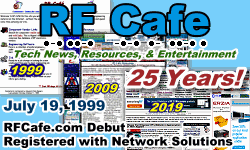|
 July 19 July 19
Today is RF Cafe Day! 1814: American firearms manufacturer
Samuel Colt
was born. 1843: The first all-metal ocean liner, the S.S. Great Britain, was launched
from Bristol, England. 1865:
Charles
Mayo, co-founder of the Mayo Clinic, was born. 1912: A meteor with an estimated
mass of 190 kg exploded over the town of
Holbrook, AZ,
causing approximately 16,000 pieces of debris to rain down on the town. 1937:
George
Parker, inventor of the the first successful fountain pen and founder of the
Parker
Pen Company, died. 1937: The official search for missing flyers
Amelia Earhart
and Fred Noonan ended. 1941: BBC World Service began regular broadcasting throughout
Europe of opening four notes of Beethoven's Fifth Symphony, which in Morse Code
spell V for "Victory" (dit, dit, dit, dah.., get it?). 1957: The first rocket with
nuclear warhead was fired from an F-89 at Yucca Flat, NV (code name
Plumbbob/John).
1961: The first in-flight movie,
By
Love Possessed, was shown on TWA. 1991: Cal Ripken played his 1,500th consecutive
game. 2010: David Ronald de Mey Warren, the Australian scientist who invented the
flight data recorder (or "black box"), died. 1999: The
RFCafe.com domain name was registered.
| Jan
| Feb | Mar |
Apr | May |
Jun | Jul |
Aug | Sep |
Oct | Nov |
Dec |
Note: These
historical tidbits have been collected from various sources, mostly on the Internet.
As detailed in
this article, there
is a lot of wrong information that is repeated hundreds of times because most websites
do not validate with authoritative sources. On RF Cafe, events with
hyperlinks have been verified. Many years ago,
I began commemorating the birthdays of notable people and events with
special RF Cafe logos.
Where available, I like to use images from postage stamps from the country where
the person or event occurred. Images used in the logos are often from open source
websites like Wikipedia, and are specifically credited with a hyperlink back to
the source where possible.
Fair Use laws permit
small samples of copyrighted content.
|








 July 19
July 19